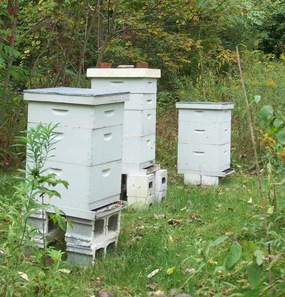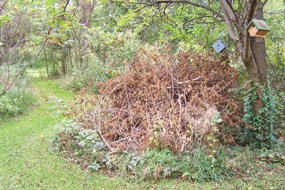|
By Volunteer Sustainability Reporter Emily Bryant At Cuyahoga Valley National Park, rangers know it is important to lead by example when teaching others about the environment and sustainability. Arrye Rosser, Interpretive and Education Specialist, is one such individual. Rosser has made many little adaptations to her home and garden that have had a positive impact on surrounding wildlife
©Arrye rosser There are many simple and attractive ways for homeowners to turn their property into a more sustainable and appealing sanctuary for nature. “Start out with what interests you and what you are excited about. For me, this is bees, birds, and butterflies. It’s fun to do backyard wildlife projects because through participating, you meet others with similar interests,” Rosser states. For example, Rosser and her family are beekeepers with three backyard hives. They regularly swap advice with other local beekeepers and the hobby has been a great conversation starter with neighbors, helping the family feel more connected to their community. 
© arrye rosser Other environmentally friendly features at Rosser’s suburban house include a bird feeding station, bird houses, many flowering plants and shrubs, nut trees, a small food garden, brush piles, a rain barrel, and a compost bin. Mud Brook flows along her one-acre property, so she created a wider border of native plants to protect the stream, a tributary of the Cuyahoga River. People passing by may notice the Certified Wildlife Habitat sign at the foot of her driveway. Qualifications for a certified habitat include sustainable yard practices (e.g., minimal use of pesticides and fertilizers) as well as providing wildlife with food, water, cover, and shelter for raising young. The application process through the National Wildlife Federation is relatively easy and inexpensive. People passing by may notice the Certified Wildlife Habitat sign at the foot of her driveway. Qualifications for a certified habitat include sustainable yard practices (e.g., minimal use of pesticides and fertilizers) as well as providing wildlife with food, water, cover, and shelter for raising young. The application process through the National Wildlife Federation is relatively easy and inexpensive. Rosser has reaped many benefits from the changes she has made to her yard. The natural vegetation and rain barrel help prevent flooding and protect water quality in Mud Brook by slowing and filtering storm water. The native plants, like sumac and goldenrod, attract more wildlife to her house and lessen the amount of grass to mow. Rosser also enjoys learning about bees and other pollinators, invasive plants, and backyard birds, and involving her family in backyard projects. While students are studying more about conservation and sustainability in school, Rosser feels that nature’s most valuable lessons come from being outdoors. “Kids aren’t experiencing the natural world as much as in previous generations. They may have more of an intellectual connection to nature, but not a lot of hands-on time. Families should really consider creating backyard habitats. It’s a satisfying way to improve and stay connected to the environment.” Last year, Rosser and her family began participating in Project FeederWatch, a Citizen Science program of the Cornell Laboratory of Ornithology. During the study period, they watch their feeders on set days and record the number and variety of birds. The experience has made Rosser more aware of how birds use her yard. For example, birds love the scrubby bushes that Rosser once considered removing. In summer, the family enjoys watching adult birds bring their fledglings to the feeders. If the birds succeed in raising their young, Rosser knows that her backyard is doing a good job in meeting their needs. As an environmental educator, Rosser knows the importance of sharing wildlife with children. “With all the negative news out there about the environment, it is important for children to know that the future can be positive if we make good choices. We need to encourage people to think about their yards as homes not just for themselves, but for native plants and animals,” Rosser explained. Her upcoming goals for her yard include making amphibian shelters with elevated wood and rocks, and planting milkweed for monarch butterflies. Get Involved
|
Last updated: April 29, 2020
